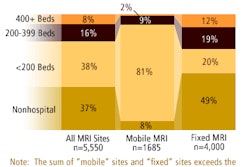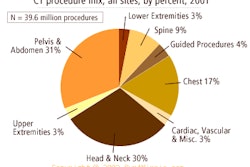When radiologists want to reduce the number of inappropriate x-ray requests they receive from primary care doctors, attaching routine educational reminders to their radiology reports will help.
That’s the finding of British researchers who, in a randomized trial, tested two different approaches to reduce the ordering of clinically useless lumbar spine and knee radiographs. Their findings were published in The Lancet (May 5, 2001, Vol.357: 9266, pp. 1406-1409).
The frequent overuse of knee radiographs and lumbar spine radiographs for lower back pain has been documented by a number of researchers, leading to guidelines published by many leading medical associations.
Six radiology departments in Scotland and northeast England participated in the study, along with 244 primary care practices that referred patients exclusively to those radiology departments. A set of Royal College of Radiologists referral guidelines for lumbar spine and knee x-rays was mailed to all of the general practitioners (GP).
The GPs were then randomly assigned to either a control group, the ongoing audit and feedback group, or the educational message group. The control group received no further information regarding x-ray requests.
The feedback group received information twice during the yearlong study, comparing their x-ray request patterns from the previous 6 months to those of other general practitioners. Meanwhile, the educational group received standardized messages attached to the radiology reports on every knee and lumbar spine radiograph requested during the study period.
On the lumbar spine x-rays, the educational message advised GPs that "in either acute (< 6 weeks) or chronic back pain, without adverse features, radiograph is not routinely indicated." On knee x-ray reports, the message stated that "in adults with knee pain, without serious locking or restriction in movement, radiograph is not routinely indicated."
The method for attaching the reminders varied among the radiology departments. Three used reporting software that attached the reports; two departments placed colored stickers with the messages onto the radiographs themselves. Both of these approaches achieved 100% or nearly 100% attachment of the routine reminders.
In the sixth radiology department, where operators had to request the addition of the message from reporting software by pressing an additional preprogrammed computer key, the attachment rate was around 40%.
After evaluating the effect of the messages versus audits or no further contact, the researchers found that routine attachment of educational reminder messages could reduce the number of inappropriate x-ray requests by 20%. In contrast, "6-monthly feedback of audit data does not reduce radiograph requests," the researchers stated.
Previous studies have found that the most effective reminders come at decision time, such as when a GP is deciding to order an x-ray, the authors wrote. Nonetheless, the Lancet group found that reminders delivered after a decision has been made should come sooner rather than 6 months later.
"Our results show that reminder prompts delivered after a decision is made can have a useful effect. The prompts probably influence later decisions, and this depends on their lasting from one decision to the next," they wrote.
"This strategy is likely to be most effective for frequent decisions," the authors concluded. "Any department of radiology that takes referrals from primary care could deliver this intervention."
By Tracie L. ThompsonAuntMinnie.com contributing writer
September 27, 2002
Related Reading
The parlous state of UK radiology, September 24, 2002
Imaging center marketing: Don't trade dollars for doughnuts, September 18, 2002
Less-cluttered MRI PACS descriptors provide clarity for referring physicians, September 12, 2002
Referring physicians give thumbs up to PACS, June 11, 2002
Copyright © 2002 AuntMinnie.com


















